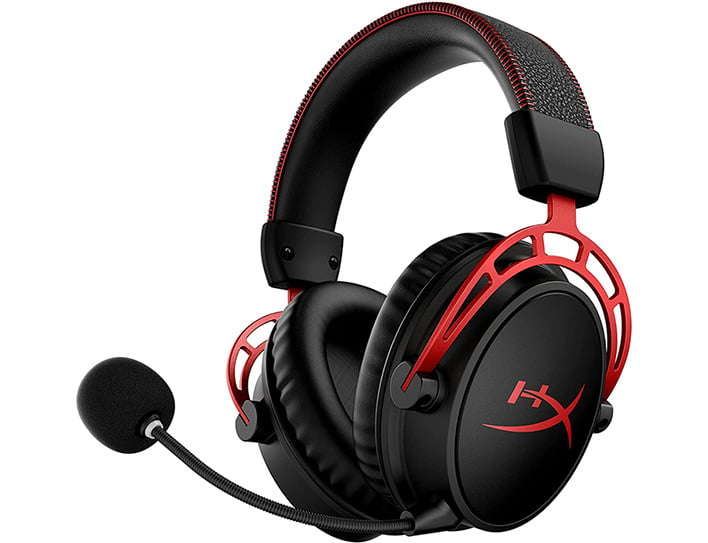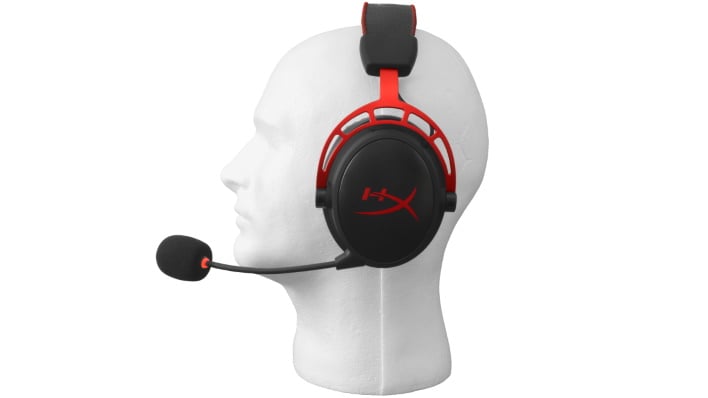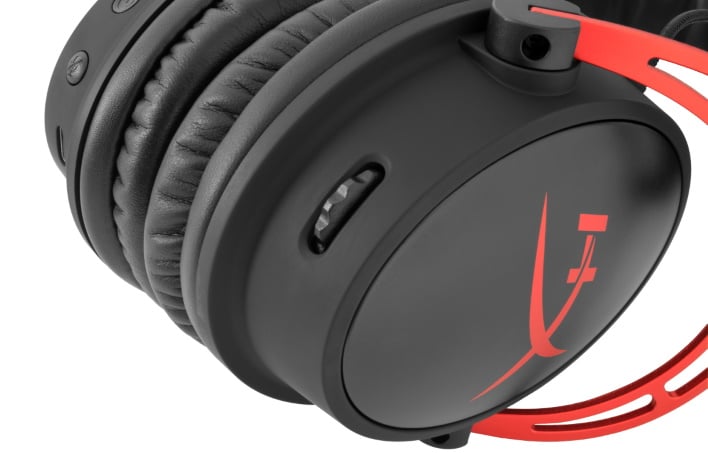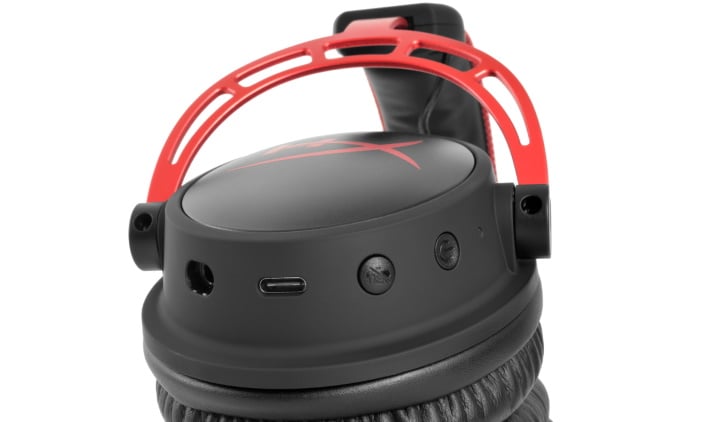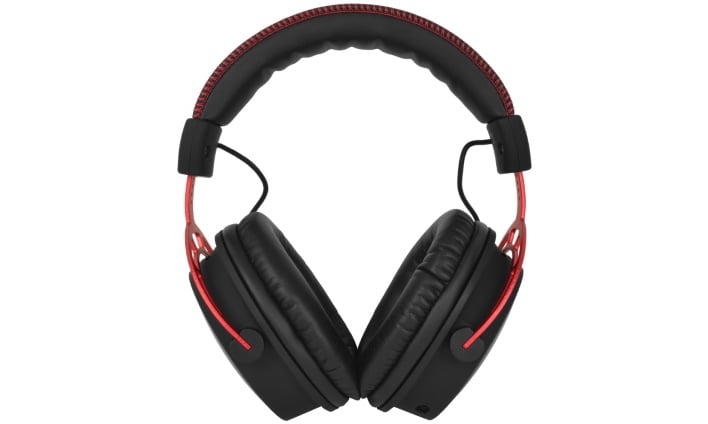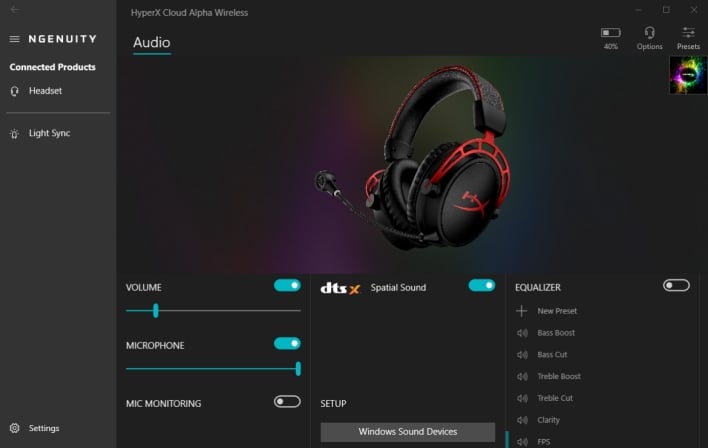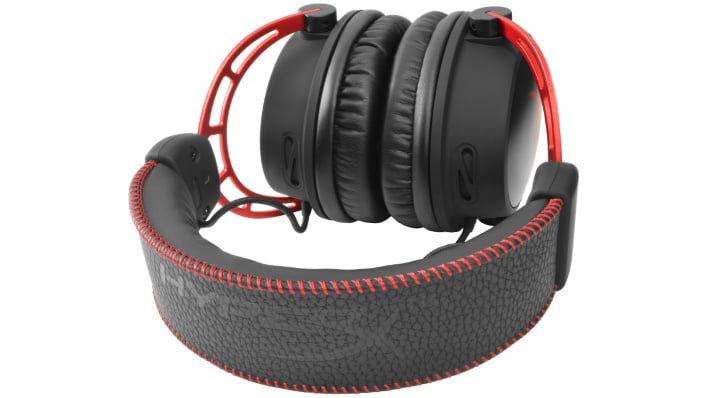HyperX Cloud Alpha Wireless Headset Review: Great Battery Life And Fidelity
HyperX Cloud Alpha Headset: Great Wireless Gaming Audio With Awesome Battery Life
Gaming headsets, in an effort to stand out from regular headphones, often sport flamboyant designs with harsh angles, polygonal shapes, and RGB LEDs. However, this styling trend can put off some gamers who have more subdued tastes or simply don’t like the stealth-fighter-Christmas-tree look. Fortunately, HyperX has a history of offering gaming headsets with more restrained, classier designs, going back to the original Cloud, which launched in 2014. The HyperX Cloud looked like a regular pair of headphones with a detachable microphone and attractive red accents. Since then, the company has steadily improved upon the Cloud formula while mostly staying true to form.
In 2017, HyperX released what was then the ultimate iteration of the Cloud design in the form of the Cloud Alpha, which featured refreshed looks, better drivers, and a significantly improved microphone. Then in 2018, the company put forward its first ever wireless headset: the Cloud Flight. Sadly, while the Cloud Flight was a good wireless gaming headset in its own right, it deviated from the recognizable Cloud design, opting for a plastic outer construction over the leatherette-wrapped aluminum band of the Cloud Alpha and others before it. The Cloud Flight also marked a step backwards in driver and microphone quality, compared to the Cloud Alpha, but carried a higher price tag.
However, now in 2022, the HyperX Cloud Alpha is taking flight and going wireless. We’re going to take a look at the new HyperX Cloud Alpha Wireless in order to see whether this gaming headset holds up without the cord. The same premium bones are there, but we’ll have to assess whether the implementation of wireless connectivity justifies doubling the price of the original Cloud Alpha.
In 2017, HyperX released what was then the ultimate iteration of the Cloud design in the form of the Cloud Alpha, which featured refreshed looks, better drivers, and a significantly improved microphone. Then in 2018, the company put forward its first ever wireless headset: the Cloud Flight. Sadly, while the Cloud Flight was a good wireless gaming headset in its own right, it deviated from the recognizable Cloud design, opting for a plastic outer construction over the leatherette-wrapped aluminum band of the Cloud Alpha and others before it. The Cloud Flight also marked a step backwards in driver and microphone quality, compared to the Cloud Alpha, but carried a higher price tag.
However, now in 2022, the HyperX Cloud Alpha is taking flight and going wireless. We’re going to take a look at the new HyperX Cloud Alpha Wireless in order to see whether this gaming headset holds up without the cord. The same premium bones are there, but we’ll have to assess whether the implementation of wireless connectivity justifies doubling the price of the original Cloud Alpha.
HyperX Cloud Alpha Wireless Design, Specs, And Features
| Headphones |
|
| Form Factor |
Over ear, circumaural, closed back |
| Drivers |
Dynamic, 50mm with neodymium magnets |
| Frequency Response |
15 - 21,000 Hz |
| Impedance |
62 Ohm |
| Sensitivity |
103 Db |
| Total Harmonic Distortion |
≤ 2% |
| Sample Rate |
48 kHz |
| Bit-Depth |
24 bit |
| Sound Output Mode |
Stereo |
| Surround Sound |
DTS Headphone: X Spatial Sound |
| Microphone |
|
| Element |
Electret condenser microphone |
| Polar Pattern |
Bi-directional, Noise-cancelling |
| Frequency Response |
50 – 7,200 Hz |
| Sensitivity |
-15 dB |
| Misc |
|
| Connection |
Wireless 2.4GHz up to 66 ft / 20 m via USB 2.0 dongle |
| Battery Life |
Up to 300 hours (50% headphone volume) |
| Charge Time |
4.5 hours |
| Charging Port |
USB-C |
| Onboard Controls |
Power On/Off, Volume, Mic Mute |
| Weight |
0.74 lbs / 335 g (0.71 lbs / 322 g without mic) |
| Pricing |
$199 - Find The HyperX Cloud Alpha @ Amazon |
The Cloud Alpha Wireless is easy to mistake for its wired twin. They both sport HyperX’s signature red-and-black color scheme and feature partially exposed aluminum bands connecting both earphones. Well-cushioned leatherette is wrapped around each of the drivers, as well as the middle of the aluminum band, where the leatherette is accented by red stitching.
HyperX Cloud Alpha Design, Build Quality And Comfort
All that said, while the design remains mostly the same, there are some small differences between the wireless and wired versions. The leatherette of the wireless version is more textured, looking more similar to genuine leather. The accented stitching is also a tad more tightly spaced, and the foam microphone windscreen is elongated. Lastly, the wireless version features a set of controls, lights, and ports not on the wired edition that we’ll go over shortly.
We still like the classy look of the Cloud Alpha after all these years, and the wireless edition doesn’t change that look is any significant way. However, as with the original Cloud Alpha, we wish there were additional color options for the Cloud Alpha Wireless beyond red-and-black. HyperX offers different color combinations for some of its other headsets, and we particularly like the gunmetal-and-black color scheme of the Cloud MIX for its subtler, tasteful appearance.
We still like the classy look of the Cloud Alpha after all these years, and the wireless edition doesn’t change that look is any significant way. However, as with the original Cloud Alpha, we wish there were additional color options for the Cloud Alpha Wireless beyond red-and-black. HyperX offers different color combinations for some of its other headsets, and we particularly like the gunmetal-and-black color scheme of the Cloud MIX for its subtler, tasteful appearance.
Beyond looks, the Cloud Alpha Wireless has the same high build quality as the wired version. The solid feel of the partially exposed aluminum band and the aluminum plates on the outside of each earphone inspire confidence in a way that plastic construction does not. The aluminum band is highly flexible, being able to bend and twist in a manner that would seem abusive for most headsets, yet it always returns to its intended form. Picking up the headset or stretching the headband doesn’t illicit a creaking sound or the feeling that the headset might break if not handled with care, which can’t be said for some other headsets. All the non-metal materials feel premium as well. The plastic composite feels pleasantly smooth and soft to the touch, but also feels solid, rather than chintzy. The leatherette doesn’t feel cheap either and is well cushioned.
The Cloud Alpha Wireless weighs a total of 336 grams (0.74 lbs.) with the microphone attached, which is one gram heavier than the wired Cloud Alpha with its cable attached. Presumably, the batteries in the wireless headset weigh about as much as the cable of the wired version. While exchanging a cable for batteries moves a bit of weight up into the earphones where it can’t be supported by a desk, lap, or chair, the difference is negligible. The Cloud Alpha Wireless feels just as comfortable on the head as the wired version and doesn’t feel heavy after many hours of continued use.
The flexibility of the headband helps with comfort too, as the headband can easily stretch to accommodate different head sizes. The headband can also extend with eleven steps of adjustability on both sides of the headset. Additionally, the points where the aluminum band meets the earphones rotate so the earphones can move to stay flat against the side of the wearer’s head regardless of one’s head size. Furthermore, the headset grips tight enough not to fall or slide off, but doesn’t apply an uncomfortable amount pressure.
The Cloud Alpha Wireless weighs a total of 336 grams (0.74 lbs.) with the microphone attached, which is one gram heavier than the wired Cloud Alpha with its cable attached. Presumably, the batteries in the wireless headset weigh about as much as the cable of the wired version. While exchanging a cable for batteries moves a bit of weight up into the earphones where it can’t be supported by a desk, lap, or chair, the difference is negligible. The Cloud Alpha Wireless feels just as comfortable on the head as the wired version and doesn’t feel heavy after many hours of continued use.
The flexibility of the headband helps with comfort too, as the headband can easily stretch to accommodate different head sizes. The headband can also extend with eleven steps of adjustability on both sides of the headset. Additionally, the points where the aluminum band meets the earphones rotate so the earphones can move to stay flat against the side of the wearer’s head regardless of one’s head size. Furthermore, the headset grips tight enough not to fall or slide off, but doesn’t apply an uncomfortable amount pressure.
The wired Cloud Alpha had a volume roller built into the cable, but the wireless version moves the volume roller up to the back of the right earphone, which is actually where we prefer it to be. Fiddling with the snaking cable to find the volume roller isn’t a very quick or easy solution to volume control compared to relying on muscle memory to reach up to the back of the headset where the volume roller always sits in the same location relative to one’s head. The volume roller on the cordless headset also has a smoother, more satisfying scrolling action than that of both the wired Cloud Alpha and the Cloud Flight. However, similar to the Cloud Flight, we wish the volume roller on the Cloud Alpha Wireless had more distinct detents, so as to aid in determining by tactile feel how far one has adjusted the volume.
The left earphone also features some new additions that aren’t present on the wired version. The wireless version retains the 3.5-mm jack for the detachable microphone, but HyperX replaced the 3.5-mm port for the wired connection with a USB-C port for charging the wireless headset’s battery. The wireless version has an on/off button, as expected, as well as a microphone mute button. The wired Cloud Alpha had a small mute switch on the cable next to the volume roller, but there wasn’t any way to tell whether the microphone was muted, other than reaching down and checking the switch, which wasn’t very convenient. Thankfully, HyperX has added a red LED ring right behind the microphone windscreen to indicate the mic’s mute status, which is super handy.
Other than the headset itself, the box contains two accessories: a USB 2.0 receiver dongle and a USB-A to USB-C charging cable. The charging cable is fairly short at just half a meter (1.64 ft), but we’re glad to see the choice of USB-C over micro USB. Plugging a micro USB cable into the Cloud Flight can be a tad frustrating at times, but that isn’t the case with the symmetrical USB-C port on the Cloud Alpha Wireless. The receiver dongle sticks with USB-A, which may be disappointing for some, particularly those rocking laptops from the fully USB-C future. Even so, we’re happy that the dongle is shorter than that of the Cloud Flight. The Cloud Flight’s receiver sticks out quite a ways, which isn’t good for laptops. After multiple years of use, the receiver for our Cloud Flight has bent slightly where the metal plug meets the plastic housing. Hopefully the Cloud Alpha Wireless’ receiver won’t have that same fate thanks to its shorter length.
HyperX Cloud Alpha Wireless Connectivity
We initially had some trouble with the Cloud Alpha Wireless, where the audio would intermittently cut out for very short periods. This behavior was surprising to us, as we’ve never observed similar behavior with the Cloud Flight over years of use, other than when standing near an active microwave. Fortunately, after consulting HyperX, we were able to address this problem by removing a wireless mouse receiver from the same USB port bank as the headset’s wireless receiver. We weren’t using the associated wireless mouse at the time, so unplugging its receiver wasn’t an issue for us. We haven’t experienced any more audio issues since then, but we still find it a little odd that a wireless mouse receiver would interfere with the headset’s wireless connection. Perhaps this interference had something to do with the wireless receiver being shorter than that of the Cloud Flight, but we’re not sure. Other reviewers seem not to have had this same issue, so there could simply be some kind of problem with our particular setup.After resolving the connection issue, our experience with the Cloud Alpha Wireless was smooth sailing from there on out. As we found with the Cloud Flight, cutting the cord and going wireless is a liberating experience. No longer being tethered by a cable running from your computer to your head means you’re free to step away from your computer at any time and continue listening to music or talking with friends. That said, wireless headsets require battery power, which has the potential to be an inconvenience depending on the battery life and charging technology.
Fortunately, the Cloud Alpha Wireless has exceptionally good battery life. According to HyperX, the battery can last up to 300 hours with the headset at 50% volume, and we believe that claim. Our review unit arrived with around 90% battery, and it lasted for almost a whole month of fairly heavy use before warning that it was low on battery. That’s quite incredible battery performance when compared to the Cloud Flight, which has an estimated battery life of just 30 hours when the LED lighting is disabled; enabling the LEDs drops that estimate down to just 13 hours. Requiring only a single charge over the course of a month pretty much eliminates the inconvenience of a battery-powered device, as far as we’re concerned.
HyperX Cloud Alpha Sound Quality
HyperX has equipped the Cloud Alpha Wireless with a pair of 50mm dual chamber drivers that the company claims are slimmer, and lighter than those of the original wired Cloud Alpha, yet retain the same audio quality. The slimmer drivers help the earcups of the wireless headset more comfortably and fully encompass the wearer’s ears than the wired version. Additionally, the audio quality of the Cloud Alpha Wireless not only matches that of the wired version, but surpasses it.Gaming headsets usually have a somewhat bass-heavy sound profile that accentuates the sounds of explosions, gunshots, and other percussive sound effects in games. While the Cloud Alpha Wireless doesn’t deviate from this formula, it still has well balanced mids and highs. The HyperX NGenuity software also has a number of audio profile presets, one of which is called “Bass Cut” and brings the bass more in line with the mids and highs. Meanwhile, the original Cloud Alpha is lacking in certain areas of the mid to high range, and sounds hollow in comparison to the wireless headset. The Cloud Flight also has insufficient midrange oomph. The Cloud Alpha Wireless has a richer and more full sound than both these headsets, particularly with Bass Cut enabled while listening to music. As with any gaming headset, audiophiles looking for a wireless pair of headphones primarily for listening to music should probably look elsewhere, but the Cloud Alpha Wireless is a very nice sounding gaming headset.
When it comes to actually gaming with this gaming headset, the Cloud Alpha Wireless knocks it out of the park. With the Bass Cut profile disabled, footsteps stand out well, helping you locate approaching enemies or keep track of team mates. Explosions and gunfire also sound appropriately punchy, heightening the sense of immersion. The optional DTS Headphone: X Spatial Audio can help increase immersion as well. This feature can make music sound funky, but enabling it in the software during gaming sessions can give you a better sense of presence. We found that this spatial audio feature pairs particularly well with the open world MMO FPS Planetside 2, in which aircraft flying overhead sounded more real with this feature enabled than we’d heard before.
The original wired HyperX Cloud Alpha had a pretty decent microphone, though it had some noticeable background static that could be a bit distracting. While the Cloud Flight microphone did away with this background static, the audio quality otherwise worsened, sounding muddled in comparison. Fortunately, the Cloud Alpha Wireless is a step up in audio quality from the Cloud Flight. The new headset’s mic doesn’t have a muddled sound, but, excepting the lack of background static, it doesn’t sound quite as clean as the mic of the original headset.
We don’t recommend the using the Cloud Alpha Wireless’ detachable microphone for video or podcast production, but it works well for gaming, as well as regular voice and video calls. We used the microphone in many hours of voice calls, and no one ever complained about intelligibility or audio quality. You can take a listen to the audio samples below to judge for yourself.
|
|
HyperX Cloud Alpha Software Experience
As mentioned above, HyperX’s NGenuity software supports the Cloud Alpha Wireless and lets users select different audio profiles, as well as make their own custom profiles. The Cloud Flight lacked any first-party equalizer software that might have helped correct for its audio shortcomings, but we’re happy to see it here. As already stated, we appreciated the Bass Cut preset while listening to music and the DTS Headphone: X Spatial Sound while gaming. The software also includes volume controls for the audio and microphone, as well the ability to change the power on/off and battery warning sound indicators. NGenuity also has a mic monitoring feature with virtually no delay, so it won’t trip you up when playing back your voice.
Gaming peripheral software doesn’t always have the most intuitive user interface, with designers often prioritizing a “gamer” aesthetic over usability. Fortunately, the NGenuity user interface is simple and straightforward. All the settings are displayed on a single page, rather than being divided among a number of unnecessary tabs or multi-layered submenus, and the interface even includes a button that takes you directly to the Windows Sound Devices menu so you can adjust settings that are handled by the operating system. NGenuity does exactly what it needs to do and doesn’t get in your way or require you to login to a HyperX account.
Gaming peripheral software doesn’t always have the most intuitive user interface, with designers often prioritizing a “gamer” aesthetic over usability. Fortunately, the NGenuity user interface is simple and straightforward. All the settings are displayed on a single page, rather than being divided among a number of unnecessary tabs or multi-layered submenus, and the interface even includes a button that takes you directly to the Windows Sound Devices menu so you can adjust settings that are handled by the operating system. NGenuity does exactly what it needs to do and doesn’t get in your way or require you to login to a HyperX account.
We only wish that NGenuity wasn’t a Microsoft Store exclusive. You can download an installation executable from the NGenuity webpage on HyperX’s website, but the installer is way out of date and failed to install when we gave it a try. However, even if this executable worked, Linux and macOS users would still be out of luck.
HyperX Cloud Alpha Wireless Headset Conclusions
HyperX already had a quality gaming headset on its hands with the Cloud Alpha and only improved on that product with the Cloud Alpha Wireless, with the only possible exception being the microphone. Like the wired version, the Cloud Alpha Wireless manages to feel comfortable, lightweight, durable, and high quality, while looking classy. However, the volume roller and mute button built into the earphones of the wireless headset are more convenient than the ones dangling midway through the cable of the wired headset. The wireless headset’s drivers sound significantly better balanced in our opinion and its earcups fully encompass the ears more comfortably. Additionally, the microphone of the Cloud Alpha Wireless doesn’t have the annoying background static of the mic in the wired version, but doesn’t sound quite as clean otherwise.
The cordless nature of the Cloud Alpha Wireless makes for a freeing experience for those coming from wired headsets like the original Cloud Alpha. The Cloud Alpha Wireless follows in the footsteps of the Cloud Flight in this respect, but we prefer the former over the latter hands down. The Cloud Flight feels like a cheaper headset by comparison, and the staggering 300 hour battery life of the Cloud Alpha Wireless beats out the Cloud Flight’s battery life by a factor of ten or even more with the LEDs enabled. The only feature we miss from the Cloud Flight is the swiveling earcups for comfortably resting the headset around the neck while not in use.
The cordless nature of the Cloud Alpha Wireless makes for a freeing experience for those coming from wired headsets like the original Cloud Alpha. The Cloud Alpha Wireless follows in the footsteps of the Cloud Flight in this respect, but we prefer the former over the latter hands down. The Cloud Flight feels like a cheaper headset by comparison, and the staggering 300 hour battery life of the Cloud Alpha Wireless beats out the Cloud Flight’s battery life by a factor of ten or even more with the LEDs enabled. The only feature we miss from the Cloud Flight is the swiveling earcups for comfortably resting the headset around the neck while not in use.
The HyperX Cloud Flight Wireless has a $199 price tag, which is a bit steep in comparison to some competitive offerings. The comparable SteelSeries Arctis 7+ is $30 cheaper, and audiophiles willing to shell out $200 should also consider traditional headphones. That said, if you want a wireless gaming headset with a premium, no-nonsense design, good audio quality, and incredible battery life, we can definitely recommend the HyperX Cloud Flight Wireless.

|
|

